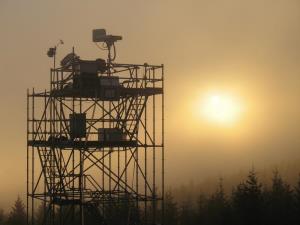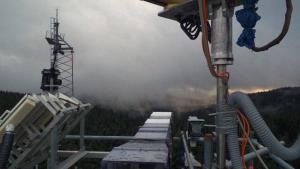

Sulfur dioxide is as antagonist of greenhouse gases less effective than previously assumed. It forms sulfate aerosol particles in the air, which reflect sunlight, and as so-called cloud condensation nuclei influence the chemical processes within clouds.
Therefore, sulfate aerosol particles help to cool the earth, making them an important factor in climate models.
However, a team around researchers from the Max Planck Institute for Chemistry found out that it is likely most models overestimate the cooling effect of these particles. The reason is a largely disregarded reaction pathway catalysed by mineral dust within clouds, which has a strong influence on the life span of sulfate aerosol particles and their ability to reflect sunlight.
In their role as condensation nuclei, aerosol particles are an important trigger for the formation of clouds. As humidity accumulates on the particles droplets are formed, which later develop into clouds. Within the clouds, however, the chemical composition of these aerosol particles changes.
In order to find out exactly what happens within the clouds, Eliza Harris and Bärbel Sinha from the Max Planck Institute for Chemistry, together with other scientists form Mainz and further research institutes, investigated different air parcels. The special feature of their experiments was that they investigated a cloud which formed on top of a mountain. The scientists could therefore trace how the aerosol particles changed while the cloud was forming.
Isotop analysis reveals how sulfate was formed
Eliza Harris' main focus was the analysis of sulfur compounds. She investigated their composition in air samples which were collected at different times: Before the parcels entered the cloud, while they were in the cloud, and after they left the cloud.
The sulfur compounds in the samples differed in the distribution of sulfur isotopes. Isotopes are atoms of the same elements differing in the number of neutrons in the core and thus can be differentiated with the help of a mass spectrometer. The NanoSIMS ion microprobe, a highly sensitive mass spectrometer, enabled Harris to look into the chemical processes. "The relative reaction rates of isotopes are like fingerprints, which tell us how the sulfate was formed from the sulfur dioxide", Eliza Harris explains her method, which was part of her doctoral research in the group of Peter Hoppe at the Max Planck Institute for Chemistry.
Role of transition metal ions in the formation of sulfate aerosols underestimated
Harris' measurements showed that sulfate in clouds forms mostly through the oxidation of sulfur dioxide (SO2) by oxygen (O2). This reaction is catalysed by so-called transition metal ions (TMI) like iron, manganese, titanium or chromium. In addition, sulfate production mostly occurred in cloud droplets which formed on large mineral dust particles, the most important source of transition metal ions. Much less often the trail led to the oxidation of SO2 by hydrogen peroxide (H2O2) and ozone (O3). "As my colleagues and I compared the basic assumptions of climate models with my results we were very surprised, because only one of twelve models considers the role of transition metal ions in the formation of sulfate", says the scientist, who is now working at the Massachusetts Institute of Technology (MIT) in the USA. Instead, most of the models used the alternative pathways of sulfur dioxide oxidation by hydrogen peroxide (H2O2), ozone (O3) and the hydroxyl radical (OH).
Sulfate produced catalytically through transition metal ions are formed on relatively large mineral dust particles, making them bigger than those formed through the reaction with hydrogen peroxide. Due to their size, they fall from the air at a faster rate - by force of gravity. The time frame for climate cooling by sulfate particles could therefore be shorter than has been believed.
A clear effect is to be expected in China and India
Eliza Harris assumes that the models have overestimated the climate cooling effect of sulfate aerosols. So far it is not quantifiable to what degree Harris' discovery will impact climate prognoses. However, future models should consider the TMI catalysis reaction as an important pathway for the oxidation of sulfur dioxide, says the scientist. She thinks that the impact on climate models of European regions might probably be low, as mineral dust concentrations in the air are small and sulfur dioxide (SO2) emissions are declining. "In India and China, however, where sulfur dioxide emissions are expected to rise in the near future, combined with significantly higher concentrations of mineral dust in the air, the effect could be stronger", assumes Harris. Future studies will show.
The study, which has been published in the journal Science, was conducted in collaboration with the following institutes: the Max Planck Institute for Chemistry in Mainz, the Leibniz Institute for Tropospheric Research in Leipzig, the Department of Atmospheric Science at Colorado State University, the Earth System Science Research Centre at the Institute of Geosciences at the University of Mainz, and the Institute of Atmospheric Physics at the University of Mainz.
Eliza Harris was recently awarded the Dieter Rampacher Prize as youngest doctoral candidate of the Max Planck Society in 2012.
[AR/PH]
Further Information:
Eliza Harris, Barbel Sinha, Dominik van Pinxteren, Andreas Tilgner, Khanneh Wadinga Fomba, Johannes Schneider, Anja Roth, Thomas Gnauk, Benjamin Fahlbusch, Stephan Mertes, Taehyoung Lee, Jeffrey Collett, Stephen Foley, Stephan Borrmann, Peter Hoppe, Hartmut Herrmann:
Enhanced Role of Transition Metal Ion Catalysis During In-Cloud Oxidation of SO2.
In: Science; Vol. 340 no. 6133 pp. 727-730, published online 10 May 2013, DOI 10.1126/science.1230911
Source: Max Planck Institute for Chemistry, Mainz, Germany
Last update: 10.05.2013
Perma link: https://www.internetchemistry.com/news/2013/may13/sulfate-aerosols.php
More chemistry: index | chemicals | lab equipment | job vacancies | sitemap
Internetchemistry: home | about | contact | imprint | privacy
© 1996 - 2023 Internetchemistry
